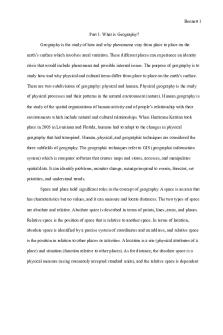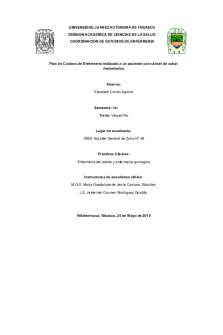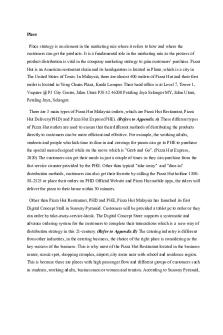Place Rebranding & Marketing Notes PDF

| Title | Place Rebranding & Marketing Notes |
|---|---|
| Course | Geography |
| Institution | University of the West of England |
| Pages | 8 |
| File Size | 572.4 KB |
| File Type | |
| Total Downloads | 87 |
| Total Views | 137 |
Summary
Download Place Rebranding & Marketing Notes PDF
Description
16th January 2016
Place Rebranding & Marketing Example exam questions • Explain and discuss the different elements that might be included in a city’s place marketing strategy • Critically evaluate the contribution that place rebranding and marketing can make to urban regeneration • Discuss whether any important lessons can be drawn from the experience of cities over the last three decades in relation to place marketing Questions (Griffiths, 1998) 1. What are the links between place marketing and urban entrepreneurialism? 2. Discuss the four ‘basic options’ for entrepreneurial strategies in cities. 3. Critique the principal place marketing approaches and place marketing as a regeneration strategy. Recap from last lecture • Branding and image management applied to places (cities and city-regions) • Deindustrialisation and strongly negative images • Ability to attract and retain mobile investment in a more globalised economy • Capacity to capture new streams of revenue based on leisure and tourism • Key element of urban entrepreneurialism • Narrow range of images of success promoted • Glasgow: key early example Main Strategies • Promotional strategies: publicity and advertising • Event-based strategies: festivals and urban spectacle • Landscape strategies: urban design, flagships and place making • Positive effects and critical issues (e.g. Dubai) Branding and Marketing places • Brand – name, recognisable, ‘statement’, marketable, reputation, profit – soft branding (changing the reputation of a place to create investment and profit) • Uses cultural identity as a saleable product (Revill and Gold, 2004) • ‘Branding is essentially about the ownership of an idea that is then transferred to an actual product’ (Ward, 2007: 136) Guggenheim in Bilbo, Spain • Sporting and cultural mega-events used for and by place promotion e.g. ‘Cultural Capitals’ Barcelona Olympics and Liverpool ECoC Not many strategies as they are all targeting the same people so you would use the same strategy Branding place for regeneration • Branding plays an increasingly important role in place promotion
•
• • • •
Place branding definition: “the conscious use of publicity and marketing to communicate selective images of specific geographical localities or areas to a target audience” (Gold and Revill, 2004: 196) • Selective images- showing the city at its best no poverty or derelict land oriented at a certain demographic Tourism, attracting like-minded industries and events Place image is vital to urban tourism (Selby, 2004) – as much as coastal or rural resorts Place re-branding or brand ‘refreshing’ often accompanied by ‘reconstruction’ (Gold and Gold, 2004) Hull City of Culture 2017
Branding place for regeneration Branding links: • Place identity • Provenance and ‘origination’ • Community and belonging Types of Branding Hard branding • New permanent built features which become ‘icons’ (e.g. Sydney Opera House, Sage Centre Gateshead) • Temporary ‘spectacle’ or major event e.g. London Olympics 2012; Glasgow 2014 CWG; Hull City of Culture) • Distinctive buildings and spaces Soft branding • Abstract qualities (e.g. innovation, design quality, creativity, fun) • See Hannigan (2003) Mobilising and culture to market cities and regeneration Key Strategies: • Deliberately cultivating artistic activity • Physical regeneration of former industrial sites (e.g. ports, abandoned city centres, factories, warehouses) • Re-imagined images/brand for the city • Creation of iconic public artefacts/buildings • Economy oriented to services/consumption/ creative and knowledge industries
(Johnson 2009)
What are the links between place marketing and urban entrepreneurialism? • • • •
Managerialism: allocation of state resources; delivery of services; social welfare ideology Entrepreneurialism: quest for new sources of economic development; alliances and partnerships; acceptance of social and spatial inequalities Place rebranding and marketing: key component of entrepreneurial cities Globally competitive economy: places traded as products
Managerialism to entrepreneurialism • Place marketing attempts to embrace two uneasily compatible objectives • External audiences: place marketing concerned with attracting globally mobile investment, consumer spending • Internal audiences: legitimise regeneration policies; morale; social cohesion • Difficult to reconcile both audiences – to keep city residents there Place marketing paradox • Globalisation: differences in functional qualities of places are flattened by communications technology • Greater emphasis on differentiation, uniqueness to get noticed; develop city myths, reimaging, visioning • But reimaging strategies homogenise places: repetition of standard devices, slogans, building types
Discuss the four ‘basic’ options’ for entrepreneurial strategies in cities Competitive advantage through production • New production technologies • Investing in social and physical infrastructure • Strengthen capacity to export goods and services Competition for consumption expenditure • Zones of retailing, entertainment and tourism • Gentrification of selected neighbourhoods • Attract high-income residents • Arts, sport, culture Acquire command and control functions • Media and communications processing • Communications infrastructure • Support services and institutional mechanisms • Agglomeration economies of specialist organisations and expertise Compete for state surpluses • National and supranational government funds • Urban regeneration programmes • National Lottery • High-value government services (e.g. defence)
Critique the principal place marketing approaches and place marketing as a regeneration strategy • • •
Promotional strategies: publicity and advertising (visual images, names, brands) Event-based strategies: festivals and urban spectacle (sporting, cultural, business) Landscape strategies: urban design, flagships and place making (spectacular high profile developments, public space)
Promotional • Limited number of common themes marketed by dissimilar places (forward; centre; quality of life) • Renaming/rebranding of places • Locally meaningful names to bland, generic, marketable names (e.g. Canon’s Marsh to Harbourside) • Uniformity and convergence rather than local variety and differentiation • Downplay problems and create attractive images
Event-based • Spectacles (e.g. Olympics) • Rituals (tradition, religion) • Artistic events programme (e.g. Edinburgh Festival) • Trade Fair (e.g. Cannes Film Festival) • Popular Fairs (e.g. Bristol balloon fiesta) • Popular citizens’ festivals (community carnivals) • High levels of risk; costly; infrastructure; saturation; neighbourhood effects; commercialisation Landscape • High profile flagship buildings • Airports, bridges, communication towers • Skyscraper office towers • Repackaging neighbourhoods and districts • Beautification programmes • Landscape theming • Fragmentation of cities • Replication of landscapes • Postmodern urban landscape Place marketing critique • Ideological effects: selective relationship between projected image and real identity
• • •
Socially regressive consequences: diverts attention away from social and economic inequalities Highly speculative nature: risk in attracting developments and spectacles Fragile basis for regeneration but cities have no option in competitive global economy
Creative industries reading • Pratt, A. (2009) Urban regeneration and culture • Issues to consider: – How have notions of ‘culture’ figured in debates about inter-city competition? – What are the arguments for adopting a ‘production’ focus, rather than a ‘consumption’ focus, in urban cultural strategies? – What are the problems of adopting an ‘instrumental’ conception of culture in relation to urban regeneration? – Can culture play an even bigger role in regeneration if it is addressed properly?...
Similar Free PDFs

Marketing Mix Place
- 1 Pages

Depresion - PLACE
- 3 Pages

Asma - PLACE
- 2 Pages

Alzheimer - PLACE
- 4 Pages

Geography/Place
- 3 Pages

Marketing Notes
- 91 Pages

Marketing notes
- 41 Pages

Marketing Notes
- 67 Pages

Place-ejemplo de TB
- 4 Pages

Place cancer de colon
- 40 Pages

Babcock Place - Grade: A
- 1 Pages
Popular Institutions
- Tinajero National High School - Annex
- Politeknik Caltex Riau
- Yokohama City University
- SGT University
- University of Al-Qadisiyah
- Divine Word College of Vigan
- Techniek College Rotterdam
- Universidade de Santiago
- Universiti Teknologi MARA Cawangan Johor Kampus Pasir Gudang
- Poltekkes Kemenkes Yogyakarta
- Baguio City National High School
- Colegio san marcos
- preparatoria uno
- Centro de Bachillerato Tecnológico Industrial y de Servicios No. 107
- Dalian Maritime University
- Quang Trung Secondary School
- Colegio Tecnológico en Informática
- Corporación Regional de Educación Superior
- Grupo CEDVA
- Dar Al Uloom University
- Centro de Estudios Preuniversitarios de la Universidad Nacional de Ingeniería
- 上智大学
- Aakash International School, Nuna Majara
- San Felipe Neri Catholic School
- Kang Chiao International School - New Taipei City
- Misamis Occidental National High School
- Institución Educativa Escuela Normal Juan Ladrilleros
- Kolehiyo ng Pantukan
- Batanes State College
- Instituto Continental
- Sekolah Menengah Kejuruan Kesehatan Kaltara (Tarakan)
- Colegio de La Inmaculada Concepcion - Cebu




